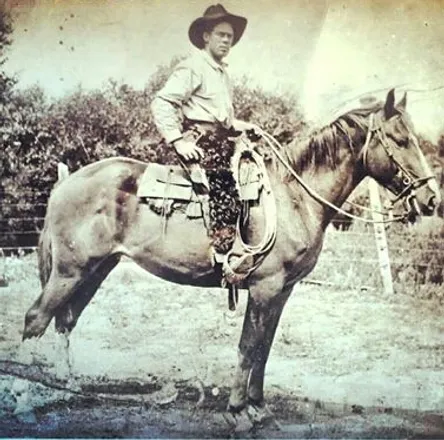There’s nothing like a fast horse to turn a young feller’s head, and way back in 1887 it was fast horses that lured 10-year-old Cam Camblin from Southeast Nebraska to Kansas. A quick, fearless, willing, and capable lad can be mighty handy around a racetrack so Cam had no trouble finding a home there for a few years. By the time he drifted to Wyoming Cam’s five-year tenure at the tracks had made a man of him, as well as a savvy horseman.
Gunmen were being imported to Wyoming by wealthy, powerful stockmen, and war simmered on the horizon. That one of the most powerful of these men, W. C. Irvine, should hire a young teenage boy for his personal bodyguard tells us a lot about the lad Cam Camblin. Along with being his bodyguard, Cam also cowboyed for Irvine, and stayed with the outfit for eight years.
The Keeline Brothers (who headquartered at the 4J Ranch and ran hundreds of horses and over 30,000 each of cows and sheep) quickly hired him to break horses and cowboy. That’s where Cam was privileged to work alongside and learn from the legendary Mexican John, summering with him at the Hoe Creek Camp on Hoe Springs southwest of Gillette and wintering further north on Barber Creek during his six year tenure with Keeline’s.
Cam figured 1906 was a good year to go into business for himself, utilizing his teamster expertise to fill a major need by freighting between ranches and small communities. He cooked for roundup outfits and also took younger brother Tut under his wing with the freighting and other draft horse work, and when a railroad spur came through from Casper heading for Forsyth, Montana, the boys and their teams were needed – at good wages.
In October of 1913 Cam married Christina Zigler, who had taken over a bunch of horses and some cows along with raising a bunch of younger siblings after her parents died. The ranch and the horses flourished, with Cam constantly improving the herd with new blood. The Camblin outfit was further enlarged by eight kids. That’s a lot of mouths to feed, so Cam supplemented their horse sales income by continuing to freight at times. His cowboy prowess was also widely known so it was not unusual for big ranchers and roundup outfits to hire him on for some of the tougher jobs.
Cam remembered top hand and Keeline Ranch foreman George Amos sending for him one time when several roundups met near Greasewood Lake on the Belle Fourche River. Around 14,000 head needed to be sorted, and Amos already knew Cam’s skill working herd and reading brands. Only the two of them would be in the herd to cut. Cam saddled his gelding Kid, the best cutting horse he ever owned, and George rode his favorite gray Snowball. After that long day in the saddle, (Cam had ridden 15 miles from home to the roundup site and home again in addition to sorting all the cattle) when he returned home he fed Kid a double portion of oats and then retired the good horse.
He sure didn’t cut himself that kind of slack – later accepting the huge responsibility of Keeline Brothers’ final roundup during which the Pumpkin Buttes served as a pivot point with all Keeline cattle found ranging northward trailed to Ucross to ship; all grazing to the east trailed to Moorcroft and shipped there; those cattle ranging south of the Buttes went to the Orpha railhead near Douglas; and all cattle found west of the Buttes were trailed to the Powder River shipping point. It was a high honor that Keeline Brothers trusted that massive gather to Cam; and possibly an even greater honor that hands like George Amos and Mexican John had recommended him. Cam collected $2 for each bull and $1 for each cow he shipped for Keeline during that work, which bought a lot of groceries and winter feed.
When Keelines loaded Cam into a railroad caboose and sent him to the Chicago Stockyards with their yearly shipment of steers he respected their trust to the extent of putting the cash in a suitcase, then handcuffing it to his wrist! He said he kept the suitcase on his lap with his other pistol-packing hand on top of the suitcase the entire trip, knowing that was “more money than most would ever see in a lifetime.”
Along with being a consummate cowboy and horseman, this Hall of Fame cowboy had a unique perception of Wyoming ranching because he’d experienced both sides of the controversial fence – big landowner and small cattle owner. He worked for, rode alongside of, and was respected by many of the most influential men in the ranching history of Wyoming Territory and Wyoming.


